Everything you need to know about poplar
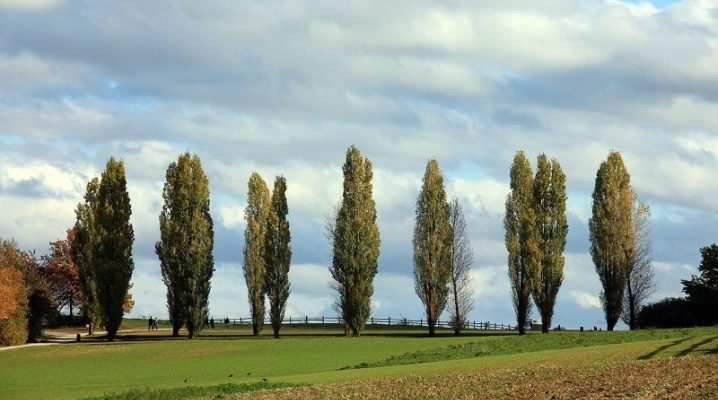
Black poplar and other species are quite common, but many people know surprisingly little about this plant. Not everyone even knows how many years he lives, and why he is planted in cities. The leaves of the trees, the month in which the poplar blooms, and how it looks, and other important information deserve attention.
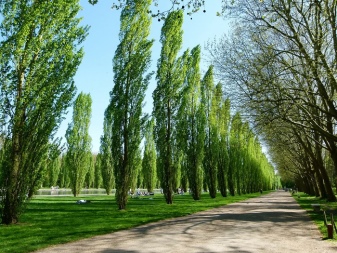
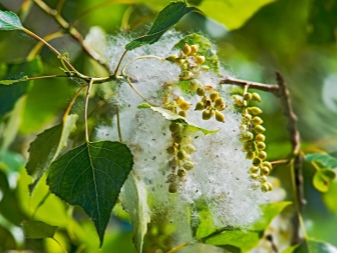
general description
From a botanical point of view, poplar is a whole genus that unites dioecious (and some monoecious) plants. This genus is part of the willow family and therefore is a close relative of the willow itself. And also such less known plants as biologically similar to it:
- abatia;
- chozenia;
- casearia;
- flakurtia;
- idezia.
The average stem height is 30-35 m. In a relatively favorable environment, it can even reach 50 m, which is a sure indicator of a good state of the external environment. The trunks themselves are straight and have a cross section of 0.6 to 1.2 m.
Other features:
- greenish-gray, silvery or black-colored bark;
- dense crown resembling a wide egg;
- large (0.5-1 cm) kidneys;
- the formation of sticky (at first) leaves from the resin.
The specific flowering period of poplar is determined by the characteristics of the region. In most regions of Russia, such a tree begins to form flowers in May. However, in the southern regions this usually occurs in April, sometimes even in the last decade of March.
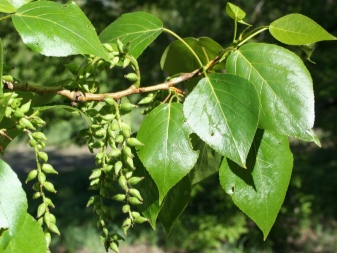
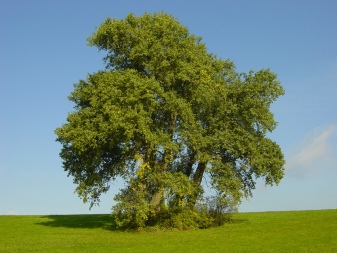
The month in which poplar blooms depends, of course, on the actual weather. The appearance of fluff, which many complain about, falls mainly in June or July. The tree will stop blooming in 14-15 days after the formation of flowers.
Poplar leaves grow in a sequential pattern. They are typically ovoid or lanceolate. The plate is distinguished by reticular venation. The usual lifespan of a poplar is from 60 to 80 years, however, some specimens live up to 120-150 years, and in the natural environment poplars are not uncommon and are 200 years old. The tree will grow rapidly from 40 to 60 years, then development slows down. Trees of this species are distinguished by an excellently formed root system. Most of the roots grow close to the surface. They will spread far beyond the crown. Mature trees spread roots within a radius of 20 m. In addition to the main roots, this species produces many offspring.
Almost everyone knows about poplar, first of all, that it gives a large amount of fluff. Initially, it was believed that with mass breeding of such trees, it is enough to simply plant "male" specimens. However, practice has shown that they are able to arbitrarily change their gender. It is difficult to say whether this is due to poor environmental conditions or unprofessional crowning, or whether this is a fundamental biological trait. Contrary to popular belief, fluff is very useful.
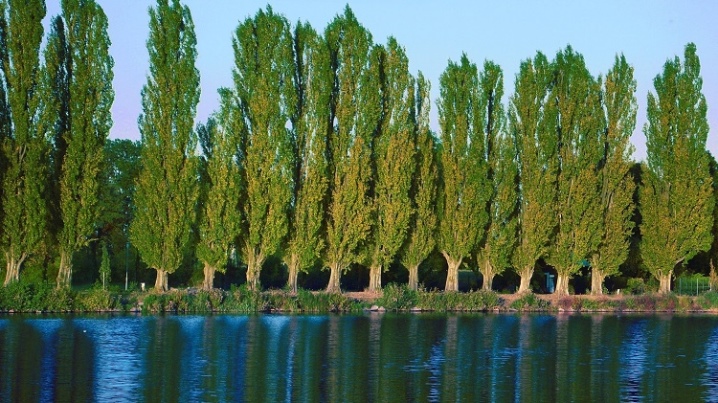
He is able to choose out of thin air:
- trichlorethylene;
- gasoline vapors;
- vapors of vinyl chloride;
- vaporous carbon tetrachloride;
- heavy metal salts;
- many carcinogenic substances;
- dust and soot.
In terms of oxygen emission into the environment, poplar surpasses:
- linden tree 3 times;
- pine 4 times;
- spruce 7 times;
- birch 10 times.
Because of these properties, poplar grows in many cities of Russia and abroad. Young poplar trees have olive bark. It is characterized by smoothness and small thickness.On mature specimens, the bark becomes thicker and darker. Longitudinal cracks of great depth are formed on it.
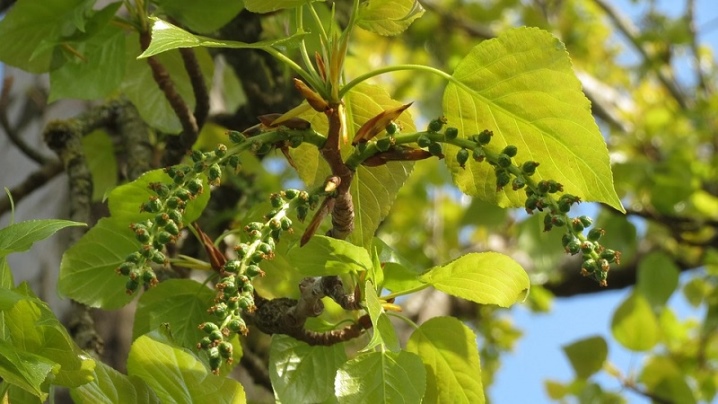
Spreading
The exact homeland of poplars has not yet been characterized. They are known to be abundant in the temperate regions of the Northern Hemisphere. They are also found in the subtropical regions of China. The northern boundary of the distribution of this species is up to the boreal zone. In North America, poplars reach south to the Mexican border, and at least one species is found in eastern Africa.
The main part of poplar trees grows naturally in river valleys and on thoroughly moistened slopes. Some of them can inhabit salt licks. And also there are similar thickets in areas where oak and spruce used to grow. The variegated poplar settles on dune sand.
These trees can be artificially planted on any land.
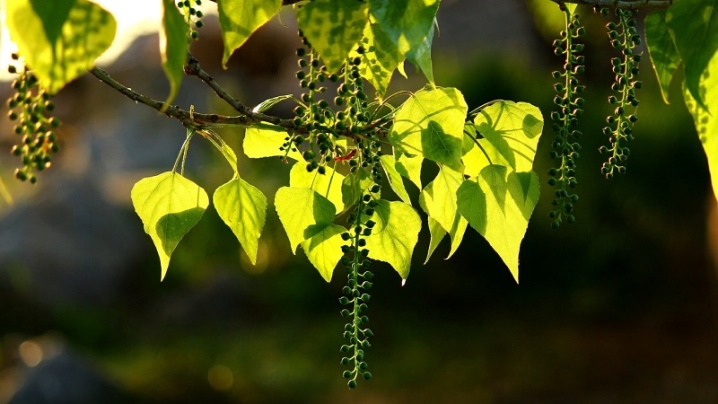
Popular types
Black poplar is a solid ornamental plant. This species in natural conditions inhabits:
- European countries;
- the territory of Kazakhstan;
- Siberia;
- states of North Africa;
- Caucasus;
- PRC.
In Russia it is customary to call it carp... You can meet such a tree both on the plain and in the river floodplain. Most often, it develops in black earth areas. Black poplars grow both singly and in mixed thickets. Frequent satellites are other poplars, willows, birches.
The trunks of the sedge grow up to 30 m. Their thickness can be 1.5 m, and the branching is not very typical. In adolescence, a gray bark appears; as it develops, it darkens strongly. Leaves with a simple structure and regular arrangement, with a finely serrated edge, are characteristic. Black poplar has dioecious flowers that are pollinated by the wind. They will appear as early as 10-20 years of development.
The trunks will be quite high Chinese poplars. They also have another name - poplar Simon. Some of these trees can grow up to 15-25 m. Smooth greenish-gray bark develops on their trunks. The crown looks very graceful and is shaped like an egg, and the shoots hang down in a cascade.
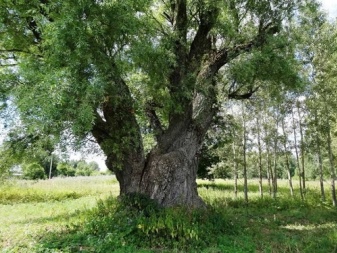
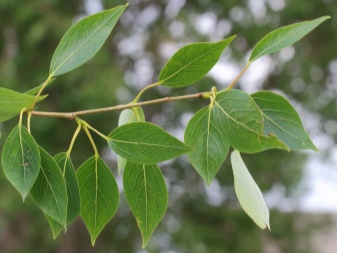
Deserves special attention aspen poplar. It is much taller than Simon's species, and can reach a height of 35 m. Red-brown branches are characteristic, which gradually turn gray. The leaf shape is from round to resembling an egg, it mainly has a diameter of 3-7 cm, and the length of the petioles reaches 6 cm. Aspen-shaped poplars are extremely widespread on the North American continent, and in the Old World they are found only in artificial plantings.
Concerning American poplars, then this name is from the "guinea pig" category. Although such a tree is widely used in the United States, it does not belong to the poplar genus. It is classified as a liriodendron. Siberian poplar - a plant whose origin is unknown. It has only been established that it is a cultivar that appeared in the second half of the twentieth century.
For practical purposes, hybrid poplar varieties are mainly used. It is worth noting that such trees are not very good in the conditions of parks and courtyards. This view was obtained in 1912. However, it only began to gain widespread acceptance in the 1970s. Determined that:
- hybrids develop 6-10 times faster than similar varieties;
- the likelihood of illness is much less;
- landing is quite easy;
- hybrid poplar is excellent for use in the production of various lumber;
- this plant is an excellent phytoremediator.
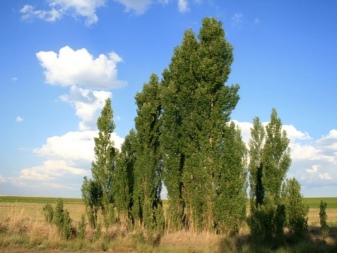
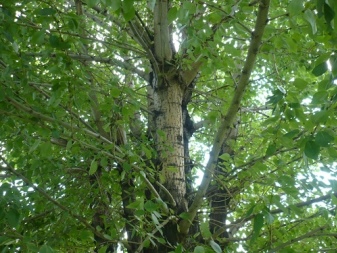
Landing
The depth of the seedling pit is from 80 to 100 cm.The gap between the planting containers can correspond to the scheme 150x300 or 250x400 cm.The root collar can be located not only at ground level, but also with a depth of 1.5-2 cm. The optimal combination in the composition soil - peat, turf soil and sand. Other important points:
- the autumn planting of poplar reduces the effectiveness of its engraftment;
- on heavy ground, drain 1/3 of the depth must be used;
- at the time of disembarkation, it is recommended to use nitroammofoska or the drug "Kemira-Universal".
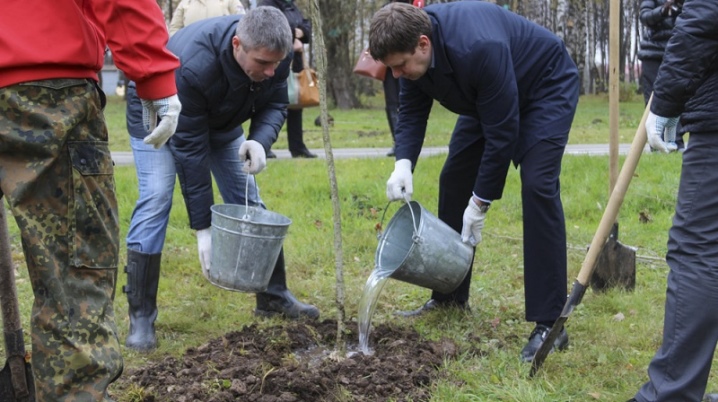
Care
The standard rules for growing poplars imply not just watering, but soaking the soil with moisture to the full depth of the roots. This means that one tree requires 20-25 liters of water. In the first season of development, watering is carried out 1 time per week, not counting especially dry periods. The near-trunk area must be loosened after each irrigation, and at the beginning and end of the growing season - bayonetted by 10-15 cm. Loosening must be abandoned at 7-9 years of development. After that, the near-stem area is equipped with a lawn.
For mulching it is recommended to use:
- peat;
- humus;
- sawdust.
Pruning and shearing does not negatively affect poplars. All cuts over 2.5 cm in size are supposed to be covered with garden pitch. Trees are pruned annually. When crowning, they strive to form a flat top, devoid of protruding branches. Active pruning is carried out before the juices begin to move.
Rejuvenation of trees involves cutting the tops by 10-15%, while it is recommended to additionally apply fertilizers.
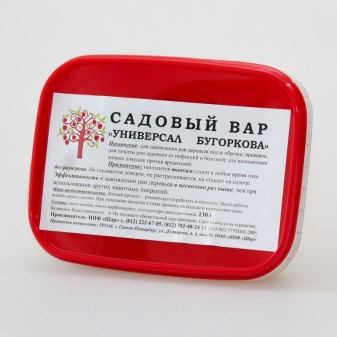

Reproduction
Cuttings
In this way, poplar reproduces very quickly and easily. Cuttings can be rooted both in water and in soil saturated with moisture. Harvesting of planting material should be done in early spring. Cutting during the warm season is highly undesirable. It is preferable to use annual shoots with a length of 20 to 30 cm.
The usual technique is as follows:
- split shoots into cuttings with 3, 4 or 5 buds;
- cuttings with loose leaves are rejected;
- leave a gap of 40-50 cm between the seedlings;
- leave at least 25% of the cutting length above the ground;
- position the stem strictly vertically;
- in dense soil, small planting containers are made in advance;
- maintain systematic watering after planting;
- after the formation of seedlings 15-20 cm long, abundant watering is stopped.
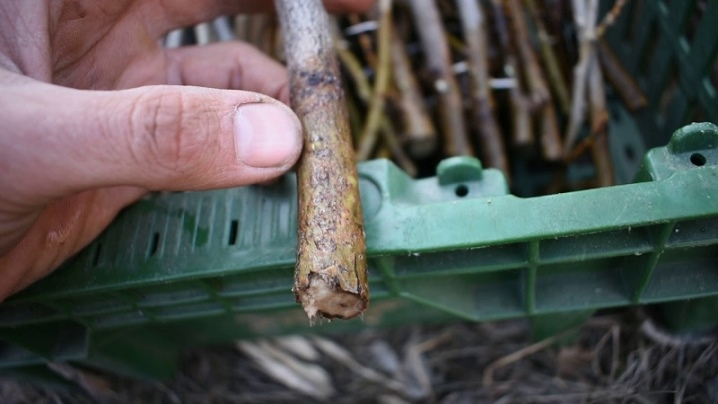
Seeds
The easiest way to collect seeds is on the ground itself, as they are easily carried by the down. Some harvest the planting material from the trees by opening the seed pods. The downside is that it must be planted in a matter of days. Otherwise, there will be no talk of any germination. Primary requirements:
- leveling areas with a rake;
- placement of boxes with seeds on the surface of the soil;
- their arrangement is both uniform and in rows (optional);
- watering the seeds from a watering can, which will allow them to deepen into the ground, but leave them on the surface;
- water the seeds regularly;
- help the rooting of planting material using a polyethylene or other shelter.
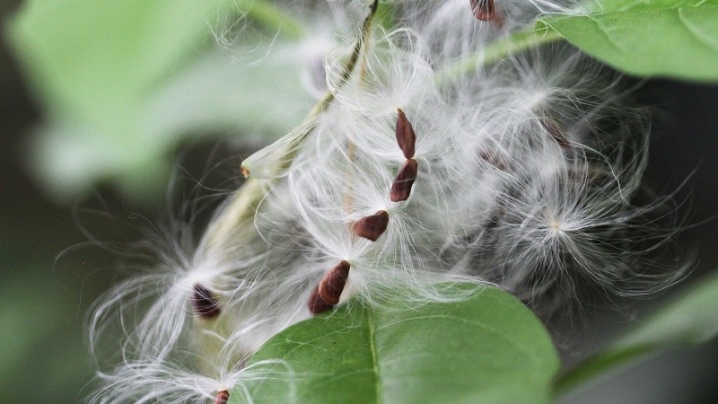
Diseases and pests
It is believed that poplar has decent immunity. And indeed it is. But still, some dangerous factors affect even such a resistant tree. Among them, most often appear:
- woody crayfish;
- woody necrosis;
- defeat by aphids, moth or leaf beetle.
Each of these problems is addressed with specific chemicals. So, poplar-spruce aphids are successfully suppressed by "Karbofos". Gallic lice is well knocked out when treated with intra-plant preparations. Moth moth is defeated by organophosphate insecticides.
Important: in any case, all drugs should be used only strictly according to the instructions, without the slightest excess of dosages.

Application
Everyone knows that poplars are planted in cities. But, in addition to the purely healing effect, the wood of these trees is also valued. Professional woodworkers have appreciated its lightness and softness. They make from such raw materials:
- paper;
- plywood;
- synthetic silk;
- lumber (both ordinary boards and outwardly attractive cuts);
- furniture;
- boats and many other significant things.
Poplar wood does not have a good calorific value.Therefore, firewood and charcoal are rarely made from it, and these products do not differ in special quality. Poplar buds produce purple dye, and foliage produces yellow dye. Young shoots of this tree can be used as feed for agriculture. Poplar bark is abundantly saturated with alkaloids. It also contains many tannins and glycosides. Once in decoctions, these substances help the nervous system and digestion. By preparing an infusion on the leaves, it will be possible to improve the healing of various wounds. And tea from poplar buds effectively suppresses inflammation, in addition, having a positive effect on the general tone of the body.
And also the therapeutic effect can be expressed in:
- improving hair condition;
- fight against depression;
- suppression of insomnia.
The landscape effect of poplars is very great. These plants can grow in areas with negligible fertility. They are often planted in regions with difficult conditions. A graceful partial shade forms under the poplar crown, and the species itself is an excellent companion of thuja, acacia and juniper. Having planted a row of trees, you can form a whole wall, a real hedge, but in the lower zone the plants are bare, and therefore you will have to do something about it.
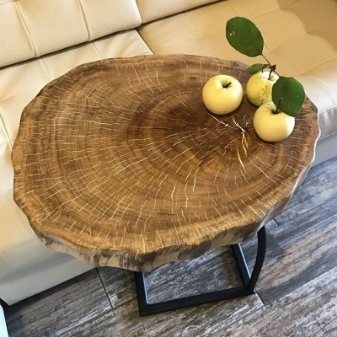
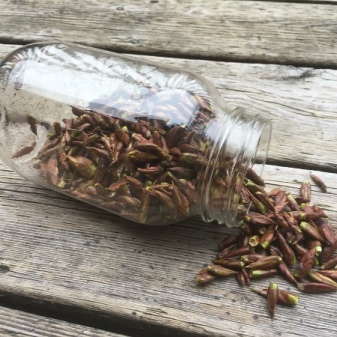
How to get rid of a tree?
Often, poplars have to be fought if they appear on the site without permission. It is not at all necessary to call employees of special firms for this. It is quite possible to destroy unnecessary wood with herbicides and other chemicals. A good reputation among approved drugs is enjoyed by:
- "Tornado";
- Roundup;
- Zenkor;
- "Prometrine".
All such products decompose quickly, that is, they do not pose any danger to farmers, pets and plants. Of course, safety is only guaranteed if the instructions are strictly followed. Arsenal and Arbonal are also performing well. They should spray the crown or water the root zone.
You can also kill poplar with sodium or ammonium nitrate.
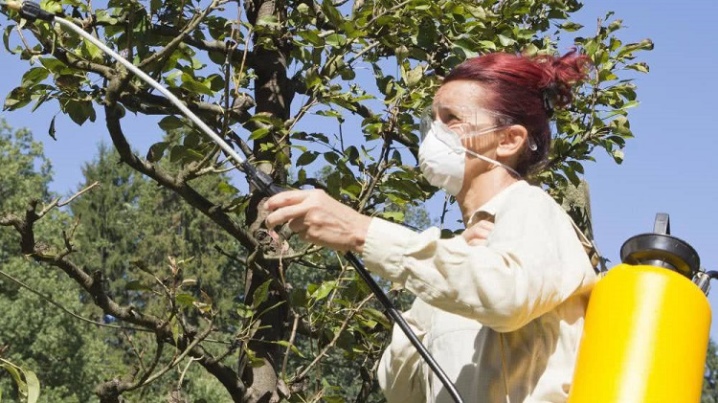



























































The comment was sent successfully.